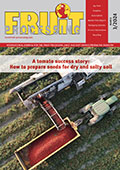WAPA, the World Apple and Pear Association, released the updated Northern Hemisphere Apple and Pear Crop Forecast. As crops have now been fully harvested since the first figures were released in August 2021, minor adjustments were made in different countries, although the new estimates are still in line with the original forecast. As the Northern Hemisphere season is getting into full swing, stocks depletion figures will be provided as well by the Association.
During the month of December, WAPA has been consolidating the forecast of apples and pears production for the Northern Hemisphere released during the month of August. As the season is now in full swing and harvest is completed, WAPA is reporting on the latest development for apples and pears in the Northern Hemisphere, while already looking to prepare the Southern Hemisphere 2022 forecast, which will be announced during the last week of February on the occasion of the WAPA Annual General Assembly. Overall, the countries survey by WAPA covers a production of 81 Mio T of apples and 23 Mio T of pears.
The updated estimates for European apple production of the 21 top EU producing countries and the United Kingdom increased by 160.000 T to stand at 11.895,000 T, which is 1,36 % more than what originally forecasted at 11.735,000 T. The forecast for the season is ultimately 11 % (or 1.195,000 T) up from the last year. The new figure is influenced by an increase in Poland (+ 130.000 T to 4,3 Mio T) as well as in Belgium (+ 48.000 T to 240.000 T) and Austria (+ 5.000 T to 120.000 T) but compensated by a decrease in France (- 12.000 T to 1.363.000 T) and the Netherlands (- 5.000 T to 245.000 T). Italy remains stable at 2.044.000 T, with 2.000 T less compared to the initial forecast of August. On the varieties side, the main changes concern Red Jonaprince (+ 53.000 T to 475.000 T), Jonagold (+ 26.000 T to 444.000 T), Idared (+ 24.000 T to 709.000 T), Red Delicious and Pinova (+ 14.000 T each, reaching 654.000 T and 197.000 T respectively), and Cripps Pink (+ 7.000 T to 240.000 T). On the other hand, Gala decreased (- 10.000 T to 1.553.000 T). Other EU countries and Switzerand represent around 200.000 T. In the USA, the apple crop is confirmed to be stable at 4,644.000 T (6 % down to last year), despite some readjustment within the breakdown by states and varieties. The major varieties in the USA are Gala (863.000 T), Red Delicious (625.000 T), and Honey Crisps (542.000 T). Varietal shift continues in the US orchards, with positive development with new varieties such as Ambrosia and Cosmic Crisp. In the US neighbourhood, Mexico’s production in 2021 was down by 2 % at 700.000 T, while Canada’s production dropped 11 % to 360.000 T. The Chinese apple crop was estimated in August just below 45 Mio T, dominated by the Shaanxi (12,5 Mio T) and Shandong (9,5 Mio T) provinces, which together account for close to 50 % of the Chinese apples production. The crop in EU neighbourhood was set at 8 Mio T, covering Turkey (4 Mio T), Russia (1,4 Mio T), Ukraine (1,3 Mio T), Moldova (600.000 T), Serbia (535.000 T), and North Macedonia (140.000 T). In Central Asia, the apple crop is around 2,5 Mio T, out of which 50 % is in Uzbekistan (1.250.000 T), followed by Azerbaijan (300.000 T), Tajikistan (250.000 T), Kazakhstan (200.000 T), and Kyrgystan (150.000 T). Production in India is forecasted at 2,65 Mio T. In the Southern Hemisphere, the final apple crop was set at 5.230.000 T.
In regard to pears, the European pear production is estimated to reach 1.666,000 T in 2021/2022, which is 3,87 % (or 61.000 T) above the August forecast. This increase is resulting from an increase in Belgium (+ 59.000 T to 354.000 T) and the Netherlands (+ 15.000T to 340.000 T) but compensated among others by a decrease in France (- 1.000 T to 56.000 T) and a further decline in the Italian crop due to the severe consequences of the climatic havocs experienced in the main producing regions (- 11.000 T to 202.000 T, while the orchard potential is over 700.000 T). On the varieties, Conference is set to increased by 68.000 T to 873.000 T while Abate should decrease by 12.000 T to
53.000 T. Regarding USA pear production, there is a slight increase from 525.000 T to 529.000 T, driven by Oregon and Washington State, while production in California is severely impacted by the lack of water and labour shortage . The main varieties for the seasons are Williams BC (270.000 T), Anjou (170.000 T), and Bosc (60.000 T). Elsewhere in the Northern Hemisphere, China reported a forecast of pear production of 18,5 Mio T, Turkey of 539.000 T, and India of 89.000 T. In the Southern Hemisphere, the 2021 pears crop ended with a total volume of 1.346.000 T.
Philippe Binard, Secretary-General of WAPA commented: “This year, given the difficult climatic conditions, forecast of production was not easy to be made, in particular regarding the uncertainties on the impact of frost and other spring weather conditions for the quality and the size of products. Looking back, the work undertaken in the different countries was rather precise, as only limited variations were noted. Those were primarily influenced by the good conditions during the summer months in the Northern Hemisphere”. Mr Binard added: “In addition to the apple and pear production forecast, WAPA collects stock figures from the major producing countries throughout the season. As of December, WAPA is resuming the collection of data for the stocks as now the crop is fully harvested and stocks data are now able to be calculated in a reliable manner”.
WAPA can reveal that EU apple stocks stood at 4,865,028 T as of 1 December 2021, which is 6.9 % above the figure of 2020, which reflects the 11 % increase in the crop. On the other hand, pear stocks stood at 654,484 T on 1 December 2021, 26,9 % below the volume of 2020, mostly because of the large decrease in Italy. In Europe, the final pear crop is 26 % lower than a year ago. For the USA, apple stocks in December stand at 1,909,045 T, down 2,58 % compared to 2020. This level is reflecting the lower crop in Washington States this year, which stands at just below 3.000,000 T, 4 % less than last year. Pears stocks in the USA stand at 224,278 T, which is 21,6 % above last year.
In regard to the current season, Domink Wozniak, President of WAPA commented: “Several factors influence the development of this Northern Hemisphere season. The rise in costs for production input, packaging, energy or labour as well as the predicted inflation will have an impact on prodcuer’s margins and competitiveness. Moreover, logistics challenges in terms of availability and costs are some of the new factors influencing trade patterns. Mixed fortune is also expected on market access considering for the European exporters the Belarus embargo as of January 1st combined with the on- going Russian embargo. For the USA, the effects of counter-sanctions in the Steel and Aluminium dossiers are affecting in particular US exports to distant markets such as India . USA trade is expected to primarily focus in North America to the Mexican and Canadian neighbours. In Asia, all exporters are confronted with increased burdens to access China due to increased COVID related controls and logistics hurdles in the port”. On the global stage, one should consider the role of new players such as Serbia, Moldova, Ukraine, Turkey, or Iran. China is also developing its export potential with exports now exceeding one million tons on apples, primarily to South East Asian neighbour. Mr Wozniak added: “Overall in the Northern Hemisphere, the local sourcing will remain a priority in many places considering on-going uncertainties on the world market. However, the growth of apple and pear production in the North Hemisphere, in particular in EU neighbourhood and Central Asia, makes it important to continue diversify the variety assortment for taste expected by consumers. Raising the quality and meeting new sustainability expectations of policy and consumers would facilitate a new boost of the consumption of apples and pears. At the same time, the global apple and pear community should continue searching for new opportunities for the apple and pear consumption in many markets around the world”.
WAPA is slated to host Prongosfruit in Belgrade (Serbia) on 10 and 11 August 2022, in cooperation with Serbia Does Apples. Information will be provided end of March 2022 on the Prognosfruit website (www.prognosfruit.eu).









